Home >
Matabeleland South >
The Southern Column’s skirmish at the Singuesi river on 2 November 1893 revisited
The Southern Column’s skirmish at the Singuesi river on 2 November 1893 revisited
Why has so little been written about the Southern Column’s campaign?
Many readers may not be familiar with the Southern Column and the skirmish[i] at the Singuesi river during the invasion of Matabeleland in 1893. The skirmish itself took place about 33 kms south of Plumtree in western Matabeleland.
The O’Mahoney’s who wrote a comprehensive article and did much research on the subject in Rhodesiana No 9 of December 1963 believed that questions were asked in the British Press about the extent to which the British South Africa Company (BSACo) – a commercial company, were aided by Imperial Forces provided by the Bechuanaland Border Police (BBP) in their Matabeleland campaign.
Mary Clarke in The Plumtree Papers also writes: “Any admission that the Imperial forces of the Bechuanaland Border Police (BBP) were necessary for the maintenance of law and order might well have led to the end of the Charter, so the part played by this column was played down.”
Soon after the event in C.7290, No 81 Sir Henry Loch, the High Commissioner at Cape Town had asked the Colonial Secretary in London to rebut such statements in the press as incorrect.
However that view is contradicted in C.7290, No 79 when Loch writes that the Salisbury and Victoria Columns had only four days food and horse forage left when the Southern Column arrived at koBulawayo on 15 November 1893 and that the Shangani Patrol that had departed on 13 November had to be re-supplied from the Southern Column’s own stocks.
In addition in C.7290, No 82 Loch pointed out that the Southern Column had diverted 8,000 amaNdebele under Gambo from attacking the Salisbury and Victoria Columns.[ii]
Background to this article
There are comprehensive articles on this website www.zimfieldguide.com regarding the events that led up to the invasion of Matabeleland in 1873 including the build-up to the Matabele War and Re-examining the events leading up to the ‘Victoria incident’ and the Newton Commission conclusions on the ‘Victoria incident’ under Masvingo Province.
Under Midlands Province is the article Iron Mine Hill (Ntabasinsimbe) and the first casualty of the 1893 Matabele War.
Under Matabeleland South are the articles Battle of Shangani (called Bonko by the amaNdebele) and Battle of Bembesi (called Egodade by the amaNdebele)
General Overview of the area
There is nothing in any of the accounts to indicate a new wagon road was cut from Tati. The Fletcher and Espin 1896 Matabeleland map {see below) shows that the Southern Column did not take the usual Hunter’s Road to the Ramaquaban river and cross at the usual drift above its confluence with the Umpakwe river. Instead they took the old road to the Victoria Falls or the Westbeech Road to the west of the Hunter’s Road and branched off east just below the Monarch Mine at present-day Francistown.
This fits with Alfred James ‘Bulala’ Taylor’s account below where he states he issued the Southern Column with axes, picks and shovels – presumably from the Monarch Mine stores. The column then cut a new wagon road to the north-east crossing the Ramaquaban and then the Umpakwe rivers and heading along the watershed to the Singuesi stream, a tributary of the Umpakwe.
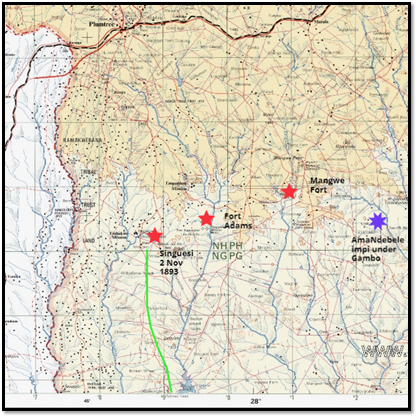
Map 1 – adapted from 1:250,000 map sheet SF-35-3 Plumtree; this map is used with
consent from Window on Rhodesia with the site name: https://www.rhodesia.me.uk
The sequence of events
5 October 1893
On this day a small BBP patrol at the Shashe river was fired upon by a party of amaNdebele. Permission was then given by Sir Henry Loch for the Salisbury and Victoria Columns to begin their march on Matabeleland. Raaff’s Rangers were ordered to liaise with the BBP and Major Hamilton Goold-Adams of the BBP was gazetted with the local rank of Lieut-Colonel in command of the combined column with the BBP gazetted for special service. (See appendix 1 for list of officers)
9 October
Khama, Chief of the Bamangwato with 2,000 of his men under the command of his brother Radikladi and his son Sekhomi; 130 of whom were mounted and armed with 450/577 Martini-Henry carbines with approximately 30 wagons and some pack-oxen left Palachwe (present-day Palapye)[iii] Marshall Hole in his book The Passing of the Black Kings writes: “Khama elated by the thought that Lobengula was to be hunted down, was anxious to be in at the death. Of his own accord, he offered the services of 1,800 of his men, including a mounted troop and announced his intention of commanding them in person.”[iv]
11 October
Lieut-Col Goold-Adams left Macloutsie[v] with a small garrison and took the vast majority of the Bechuanaland Border Police (BBP) consisting of 225 officers[vi] and men, 210 horses, 4 Maxim guns,[vii] 2 seven-pounder guns, 14 wagons and 50 native drivers and herders.
He was joined on 11 October in the Bechuanaland Protectorate by Commandant Pieter Edward (Johannes) Raaff[viii]. Raaff who in 1893 was employed by the British South Africa Company (BSACo) as the resident magistrate of the Fort Tuli district in the south-west was directed to raise a force to be officially called the Transvaal Rangers[ix] but is usually referred to as Raaff’s Rangers. This consisted of 225 officers and men, 191 horses, 1 Maxim gun with 11 wagons and their drivers.
Raaff had initially been involved in purchasing horses for the Salisbury Column that were sent in batches to Fort Charter where the Column did most of its training – many arrived in poor condition. He then went to Johannesburg and recruited the men and officers on behalf of the BSACo with a promise of no pay, but rations, a farm in Matabeleland of 3,000 morgen (6,350 acres) and 20 reef and 5 alluvial gold claims. Morris-Newman writes: “the stamp of men attracted by this filibustering offer may easily be imagined.”[x]
A mounted force of 145 BBP and 70 BSACo men – pushed on as quickly as possible for Tati with the remainder of the men and the wagons following on behind.
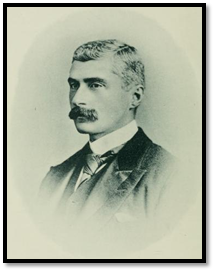
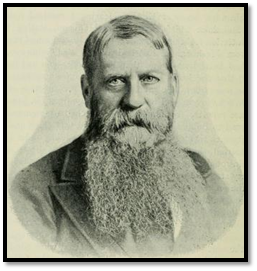
Lt-Col Hamilton Goold-Adams Sir Henry Brougham Loch
13 October
Goold-Adams and the BBP / BSACo force met up with Khama’s force at the Shashe river.
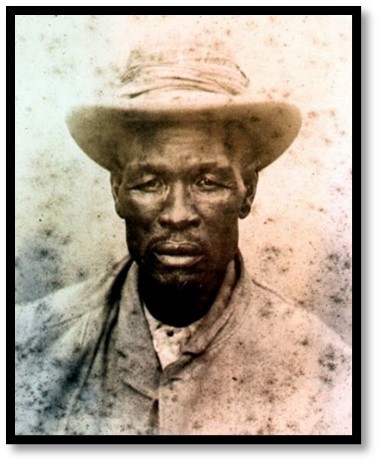
Chief Khama III
14 October
Goold-Adams was told that water was very short at Tati so he moved his BBP / BSACo force of 215 mounted men on to the south bank of the Tati river 9 kms away but left Khama’s force at the Shashe river to wait the arrival of the rear-guard and wagons that were planned to arrive at the Shashe river on the 18 October.
18 October
The BBP / BSACo force remained at the south bank of the Tati river for four days during which the unfortunate shooting of the amaNdebele envoys of Lobengula’s half-brother Ingubogubo, Mantusa in command of the Mabokotivani regiment and Ingubo occurred on the 18 October. [See appendix 2 below]
19 October
The BBP / BSACo force was joined by Chief Khama’s force and the rear-guard and wagons and they crossed the Tati river during the day. The combined Southern Column now consisted of 440 Europeans, 2,000 natives, 520 horses, 55 wagons and 2,000 oxen…quite a logistical challenge.
The initial plan was to trek from Tati to the Monarch Mine at present-day Francistown – a map distance of 48 kms but to be reached via the Ramaquaban river. From there to go east along the route of the present-day railway line to Bulawayo taking a route along the watershed and reaching the main road from the Mangwe Pass at Figtree.
The plan included:
- Sending a mounted diversionary force made up of 100 Raaff’s Rangers plus 100 of Khama’s mounted men up the Hunter’s Road to Makobi’s kraal to cover the advance of the wagons and main force up the Ramaquaban river. No amaNdebele forces had been spotted, but the tracks of scouting parties had been seen and it was clear the force was probably under observation from the outlying kopjes to the east.
- Selous and Farley to take a scouting party up the Ramaquaban river to establish how viable the route was for the wagons. However it soon became apparent from Selous’ report that the shortage of water on the upper reaches of the Ramaquaban made this route impossible for the column’s horses and oxen.
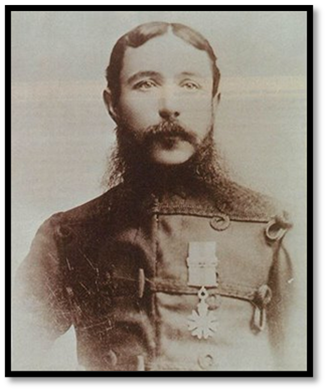
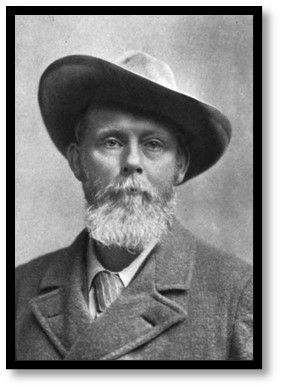
Commandant Pieter Johannes Raaff Frederick Courteney Selous – chief of the intelligence
department of the Southern Column
In consequence of the above, Goold-Adams decided to move to the headwaters of the Umpakwe or Ingwizi rivers and to skirt the broken kopje country of the western Matobo.
As he considered it impossible to take a large force he took only 190 BBP and 200 BSACo – all mounted with 12 wagons, 3 Maxim guns and the two seven-pounder guns leaving Khama and is men and the remainder of his force (35 BBP and 25 BSACo) at the Ramaquaban river to follow on behind.
Enroute a number of small kraals were burnt down by the BBP / BSACo force.
Mary Clarke quotes Alfred James ‘Bulala’ Taylor as follows: “Fred Selous introduced me to Col Raaff before the column left. We had a long talk regarding the country, roads and natives. A detachment of Raaff’s mounted men under Capt Francis left, following the main road to Bulawayo. I went with the main body towards the Monarch Mine where I handed out axes, picks and shovels. Selous said he was going to lead them straight through Malaba and cut the main road north of the Mangwe Pass. They would have been alright but they made straight for Mangwe past Mfulumbanje and Uzibaba. I returned to Tati and found a Capt Atwell had arrived with wagons containing ammunition, etc. He refused to go on without a guide and escort. I had an interview with Capt Lendy who was temporarily in charge at Tati and arranged to guide the wagons to the column. I took a Boer (I had previously known, named T. Vermaak, who was one of the transport riders) and rode on in front to the river ‘til we were close to the column. He then turned back. Mfulumbanje is where the column had a skirmish with the natives.”
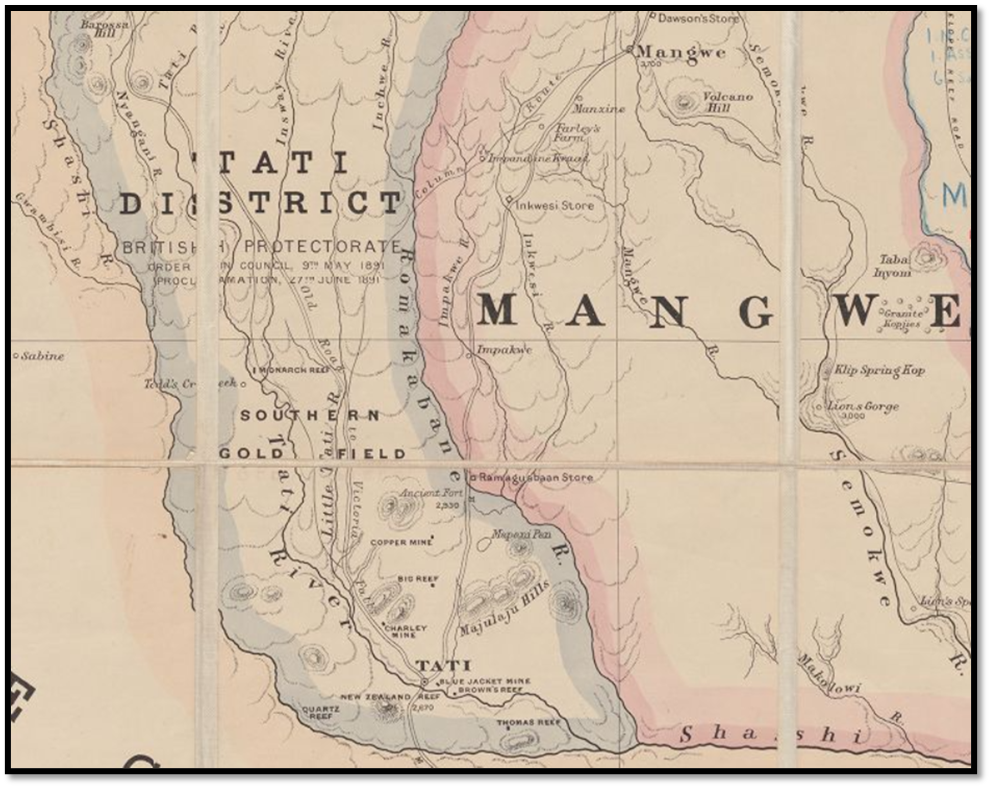
Map 2 - Fletcher and Espin 1896 Matabeleland map – Tati / Mangwe portion
29 October
The mounted men of the Southern Column arrived near the headwaters of the Singuesi river and formed a laager pending the arrival of the wagons.[xi]
Local Makalaka tribespeople informed Goold-Adams that the amaNdebele had gathered in their cattle and taken them into the Matobo Hills and that there were at least two amaNdebele impis in the vicinity under their commander Gambo – one at the Simukwe river 35 kms to the east and another at Khosingnana at the north-eastern edge of the Matobo Hills.[xii] They also said there was insufficient water for Goold-Adams’ large force to skirt around the Matobo.
30 October
Goold-Adams decided they should get Khama and the remaining force to move from the Ramaquaban river and to join them at their current position on the Singuesi. From there they would move east to the edge of the Matobo and provoke the amaNdebele into attacking the Column or if not, try and take their strongholds by force.
Goold-Adams concedes that their camp position was not the strongest, but it was the best that could be found near water. “There were high kopjes of from 150 – 300 feet about 1,000 yards (915 metres) to the south and south-east of the laager and rising ground from the bank of the river.”
The Scouts under Selous and Farley[xiii] had advised that the Singuesi laager site was suitable for a morning laager only as it was surrounded by thick bush and dominated by rocky kopjes.[xiv] However Goold-Adams decided he needed to give the wagons and Captain Tancred’s rear-guard a chance to catch up with the main force. It was a good thing he did as subsequent events revealed.
1 November
Khama arrived in the afternoon with his 130 mounted men and wagons and set up camp 180 metres to the east of the laager.[xv] However later in the evening Goold-Adams received a message from Capt Tancred saying he had been forced to stop for the night about 5 km south of the laager in order to rest the oxen because of their poor condition. An order was sent back that he should start at sunrise next day and bring the wagons to the laager.
In view of the scouts previous day warning, Goold-Adams should probably have sent out an escort to meet the wagons the next day. There were pickets posted on the outlying kopjes but they seem to have completely missed the presence of the 600 – 700 armed amaNdebele to their south.
2 November – the Singuesi skirmish[xvi]
Captain Tancred’s force consisted of 35 men of the BBP, 10 of the BSACo, about 100 African drivers and leaders, 2 Maxims and about 25 wagons. His oxen were ‘knocked up’ by the shortage of water and he had therefore outspanned at a river about 3 miles (5 km) from the main force.
As instructed the wagons set off at sunrise, but Tancred took 20 of the wagons (10 BBP / 10 BSACo) and about 50 Africans with the remaining wagons staying with Lt Schofield with instructions to follow on when they were ready.
At about 8:15 am the wagons under Tancred were ambushed 2½ km from the laager as they rounded the Mfulumbanje hill. Gambo had detached 600 - 700 amaNdebele from the Amabugudwana and Nyamavendlhovu regiments under Bokwela to reconnoitre the Southern Column.
The left flank of the amaNdebele regiments suddenly came across the advancing rear-guard and wagons and attacked. The O’Mahoney’s write the rearmost wagon containing the quartermasters’ store was overturned and burnt with the native driver and Cpl Mundy[xvii] being killed, the stores destroyed and the oxen taken away. Morris-Newman writes that the amaNdebele attacked the centre-wagon in the train of about 20 wagons extended in a straggling line over one kilometre long and before the unfortunate man in charge of that wagon, Cpl Mundy of the BBP could receive assistance, he was shot with his driver, the leader or voorlooper escaping. He writes it was a canteen wagon and soon ablaze. Captain Tancred hearing the firing hastened up from the rear with one Maxim and 35 troopers and returned fire.[xviii]
The sound of firing was heard at the laager and the men rushed for their horses. Two Troops of the BBP with Selous at their head were quick to ride out to where the fighting was taking place. The O’Mahoney’s write that Selous was wounded in the leg by a shot fired at point blank range but continued to fight. Morris-Newman writes that a bullet glanced off his left-side ribs and although hurt, he remounted and carried on shooting.[xix]
Selous in a letter to his mother wrote: "There was a bit of a fight and the Matabele were driven off with considerable loss. I was unfortunate enough to get wounded. As I am in very good health, this wound is not at all dangerous, though, of course, it makes me very stiff and sore all down the right side, but I shall soon be all right again."[xx]
Along with Capt Tancred’s mixed rear-guard Troop of BBP and BSACo men, Selous and the two BBP Troops manage to hold off the amaNdebele from the remaining wagons but as amaNdebele reinforcements arrived they gradually and purposefully fell back pursued closely by the amaNdebele in the bush on either side until at a point 150 metres from the laager, the Maxim guns at the corners opened fire. The amaNdebele could not withstand this heavy fusillade and those in the open now found themselves caught in crossfire, the Nyamavendlhovu regiment suffering the most casualties. In disarray, they broke off their attack and retired into the rough kopje country and hills to the south-west.
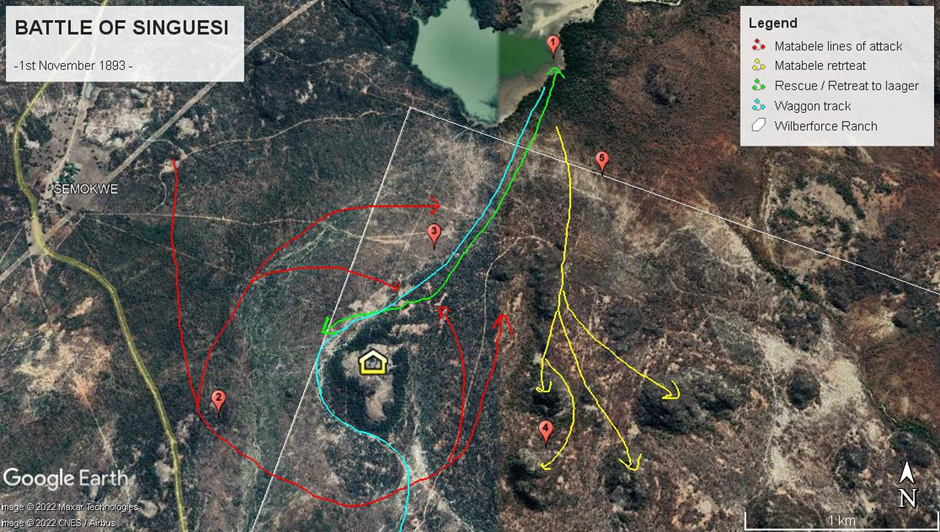
Graphic design by Courteney Johnson
F.C. Selous’ account of the Singuesi skirmish
Selous account to his future wife, Gladys Maddy, gives more detail: “Owing to the miserable state of the oxen, a portion of the waggons did not get up to us on November 1st, but were left behind at a distance of about three miles from our main column and the oxen sent on to the water. After drinking they were sent back at once, and early on the morning of November 2nd the waggons came on. Soon afterwards we heard heavy firing and knew that the convoy was attacked. As there were but few men with the convoy, assistance was urgently needed, we knew, and the alarm was at once sounded and the horses called in. I got hold of my horse long before the troop horses came in, and, saddling him up, galloped back alone to help the fellows with the waggons. They were not far off and were being attacked on all sides by the Matabele, who were keeping up a hot fire and closing in on both flanks and from the rear. Our fellows were sticking to it well, though in small numbers.
My appearance, I think, checked the Matabele a little, as, seeing one horseman gallop up, they naturally thought more were at hand. However, as I was very near them, and firing away at them, they fired a lot of shots at me. The whistling of the bullets made my horse very restive, and presently one of them hit me. The wound, however, is not dangerous. The bullet struck me about three inches below the right breast, but luckily ran round my ribs and came out behind, about eight inches from where it entered. The Matabele came right up to our camp, some being shot within three hundred yards of the laager with the Maxim. They were then beaten off and a good many of them killed, and had it not been that they got into a lot of thickly wooded hills close behind our camp their loss would have been much heavier.
Our loss was two white men killed, and three wounded, including myself, and of our native allies two killed and several wounded. Before I came up the Matabele had captured a waggon, which they burnt, and killed Corporal Mundy, who was in charge of it. Sergeant Dahm was killed and two other men wounded after the Matabele had been driven off from the camp and whilst they were fighting them in a hill.
Yesterday we pushed on and took up a splendid position here, where if we are attacked we shall be able to give a good account of ourselves."[xxi]
Khama’s men then stormed into the hills whilst the BBP formed a cordon around the base of the hills to try and prevent the amaNdebele escaping. The seven-pounders hills afterwards shelled the hills for about an hour.
The Southern Column’s losses were three of Khama’s men killed with 7 injured. Regimental Sgt-Major Dahm of Raaff’s Rangers was killed during the attack on the hills with Sgt-Major Robertson[xxii] and Sgt Dempsey and Trooper Robinson wounded; the BBP had Cpl Mundy and a native driver killed, Sgt-Major Codrington and Cpl Ransome wounded. Raaff’s Rangers then withdrew and two Bamangwato regiments under Sikumi were ordered to clear the hills which they attempted with great determination. The amaNdebele lost 60 killed and many wounded who got away.
By 1:30pm the skirmish was all over. At nightfall the amaNdebele came out of the caves where they had been hidden and moved east towards Mangwe and the Matobo Hills.[xxiii]
This was probably only the third time that Maxim guns had been used in action after the battles of Shangani (Bonko) and Bembesi (Egodade) on 25 October and 1 November 1893. It was reported that at Shangani and Bembesi amaNdebele casualties suffered were 500 and almost 1,000 respectively.[xxiv] However these are estimates only; Singuesi casualties were based on a body count.
In all probability the Maxim guns were probably not effectively employed as there was a confused melee of wagons and oxen, retiring troopers and advancing amaNdebele in front of the laager and there were not the clear fields of fire as at Shangani and particularly at Bembesi.
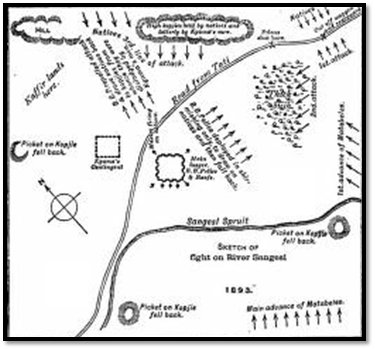
Morris-Newman’s diagram of the action – his north is incorrect and should read south
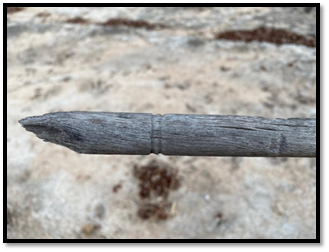
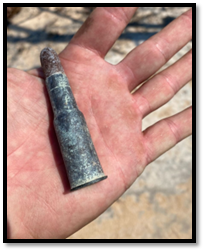
Photos from Courteney Johnson: assegai shaft found in the hills and a Martini-Henry .450/577 black powder centre-fire cartridge found south of the laager site
3 November
Goold-Adams moved the Southern Column laager 8 kms to the north-east to a better position near the site of the old Empandeni Mission[xxv] where Fort Adams is built.[xxvi]
On the same day at koBulawayo three of the Salisbury / Victoria Column’s scouts, Burnham, Ingram and Vavasour heard the explosion and smoke following the destruction of the king’s storehouse and arrived at the king’s kraal a few hours later to find it deserted and James Fairbairn and William Usher playing poker on the roof of James Dawson’s store.[xxvii]
4 November
The Salisbury / Victoria Column scouts Burnham and Ingram who had left koBulawayo the previous evening reached Goold-Adams in the afternoon with despatches from Dr Jameson confirming that koBulawayo had been occupied on 3 November and that Lobengula had fled northwards.[xxviii]
5 November
Just as the Southern Column was about to move onto Mangwe Chief Khama told Goold-Adams that neither he nor his men would go any further…he said smallpox had broken out in the Bechuanaland Protectorate and that he needed to get back to his people. Goold-Adams reminded Khama that he had agreed with Sir Henry Loch[xxix] to place 1,000 of his men under Goold-Adams command.
Khama replied that he knew that, but the smallpox outbreak was urgent and he must return and that he agreed that he would forfeit any claim to pay for his men. Goold-Adams tried to persuade Khama to leave some wagons and oxen to advance nearer the Matobo, but Khama would not agree to do this. He did however agree to stay in the present position at Empandeni[xxx] until Goold-Adams had moved his Southern Column to their new position, but within 30 minutes sent a new message saying he could not wait.[xxxi]
As many of the Southern Column’s oxen were in poor condition their loads had been lightened by off-loading onto Khama’s wagons. These were now off-loaded before Khama’s wagons left for Tati and then Palapye. The transport of these supplies owing to the poor state of his oxen presented Goold-Adams with a logistical problem.
Within a few hours of Khama’s leaving the Makalaka chiefs Malaba and Manyame sent councillors asking for protection for their people. They also gave the news that the combined Salisbury and Victoria Columns had reached koBulawayo, Lobengula’s capital on 3 November although scouting parties had arrived the previous day in time to watch as Lobengula’s storehouse was blown up and they knew that Lobengula himself had fled to the north. They also stated that the impi that had been situated at the Simukwe river had left in the direction of the Gwaai (Gwayi) river.
Gambo, the amaNdebele commander also heard that that the best regiments of the amaNdebele had been broken at Bembesi and disheartened, abandoned his position at the Simukwe river east of Mangwe Pass leaving the Hunter’s Road open and undefended.
6 November
A force of 100 mounted men under Raaff was quickly assembled and sent due east to the Mangwe river to see if the Hunter’s Road and the Mangwe Pass was still open. Once confirmed a small force of 50 men under Lieut Munro with 2 Maxim guns was left at Fort Adams (National Monument No 88) - 5 km from Singuesi and the remainder of the Southern Column moved to Mangwe. Another small force under Capt Williams was left at Fort Mangwe.
7 November
Raaff and his mounted force reached the Khami river that night. From Bulawayo ten spans of oxen were sent to the Khami under Captain Judd with orders from Dr Jameson that he was to return to the Southern Column and assist in bringing them on. The reason for this was that there was little food or forage at koBulawayo and the supplies that Goold-Adams had in his wagons were needed urgently.[xxxii]
12 November
Lieut-Col Goold-Adams rode into koBulawayo in the evening from the Khami river where the Southern Column was camped.
13 November
Goold-Adams returned to the Khami river with instructions to send onto koBulawayo 150 mounted men from the Southern Column under Captain Raaff with two Maxims and a seven-pounder gun drawn by ten mules to join the force that would be following Chief Lobengula.
14 November
The force under Raaff arrived at koBulawayo consisting of 90 BBP and 60 BSACo with the two Maxims and seven-pounder under Capt Coventry.
15 November
The remainder of the Southern Column reached koBulawayo.
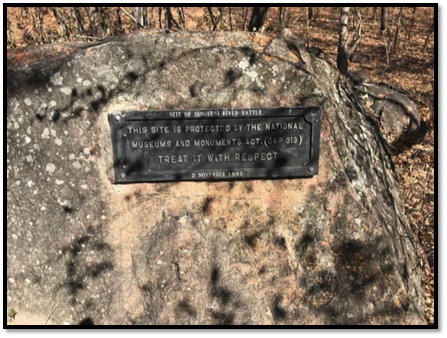
Photo from Courteney Johnson: the Historical Monuments plaque near the Embakwe Dam
H.L. Stevens: Autobiography of a border policemen
This book is very hard to find and I have not read it, but the O’Mahoney’s state that it gives a more detailed account of the Singuesi fight that Stevens took part in as a BBP Trooper and differs as to the time of day, where Selous was wounded, the amaNdebele casualties and the actions of the BBP on that day in going to the assistance of the wagons and repelling the attacks on the laagers.
Appendix 1: Officers
Bechuanaland Border Force (BBF) and Bamangwato forces | ||
Lieut-Colonel H. Goold-Adams | Royal Scots | In Command |
Major Browne | Royal Artillery | 2 i/c |
Capt Walford | 23rd Royal Welsh Fusiliers | Staff Officer |
Capt Heyman | Intelligence / Transport Officer | |
Surgeon Garroway | Medical Officer | |
Capt Molyneaux | Quartermaster | |
F.C. Selous | Guide | |
F.C. Farley | Guide | |
H. Moffatt | Interpreter | |
E and K Troops | ||
Capt Hon C. Coventry | In Command | |
Lieut Drury | ||
Lieut Phipps | ||
F Troop | ||
Capt Tancred | Royal Artillery | In Command |
Lieut Munro | ||
Lieut Williams | ||
Lieut Schofield | ||
Khama III | Chief of the Bamangwato | |
Sekhomi | Maphatswa Regiment | |
Sephekolo | Maalola Regiment | |
Seeletswe | Maemeloa Regiment | |
Seretse | Maloelamotse Regiment | |
Appendix 2: The shooting of the amaNdebele envoys
John Smith Moffatt, the assistant commissioner at Palachwe (Palapye) sent messages to Lobengula saying he should send amaNdebele envoys to see Sir Henry Loch to try and settle the situation after the ‘Victoria incident’ in an amicable way. Lobengula sent his half-brother Ingubogubo, Mantusa in command of the Mabokotivani regiment, and Ingubo and asked James Dawson, a trader at koBulawayo,[xxxiii] to accompany them to Palachwe (Palapye) They left koBulawayo on horses on 16 October and arrived at the Tati Company’s store two days later in the afternoon.
According to Major Sawyer’s report, made at Loch’s request after the incident, the armed party off-saddled in the yard and the amaNdebele were left by Dawson. Morris-Newman writes that Dawson met with Goold-Adams, Selous, Kirby and others, but gave no explanation about the amaNdebele presence to anyone of their mission which was semi-secret. Wills and Collingridge state Dawson went off for some refreshments with Selous and left the envoys.
The amaNdebele envoys walked around the yard but gave no explanation for their presence. Morris-Newman writes: “Mantusa, a noted enemy of all Europeans, became very saucy and refused to state what they had come for, where they were going and why they carried arms in a military camp.”[xxxiv] As no satisfactory answers were received - Dawson does not seem to have been in the vicinity, a guard was ordered to take the three amaNdebele across the Tuli river to the camp on the southern side where they were told they would be fed, and if satisfactory answers were received, they would be allowed to go on in the morning.
They crossed the river, but in the camp Mantusa snatched a bayonet from a guard, stabbed two soldiers with it and ran away, being shot dead by the first soldier he wounded. Ingubo also tried to run and was also shot dead. Ingubogubo did not move and when Dawson crossed the river he was told of the unfortunate turn of events. He took Ingubogubo to Palachwe the next day from where J.S. Moffat telegraphed the news to Sir Henry Loch.
The Morris-Newman and Wills and Collingridge accounts differ a lot in detail; with Morris-Newman saying Ingubo was clubbed by a soldier, but then reports just Ingubogubo surviving.
Alfred James ‘Bulala’ Taylor’s account in The Plumtree Papers goes as follows: “A day or so afterwards Jimmy Dawson, Montusi and two other indunas arrived on horseback. Dawson went into one of the huts and evidently forgotten them. I took their horses and had them fed. I asked them where they were going. Montusi said: ‘We are sent. Dawson knows and has money.’ I sent over to Col Goold-Adams, he came over and asked them what they wanted. They just said: ‘We are sent.’ The Colonel asked me to keep an eye on them ‘til he sent for them. Shortly afterwards Lieut. Phipps came and said he had orders to bring them to camp where they would get food and blankets. I told them that the Colonel would talk to them in the morning. Montusi stood up and reached for his rifle. I was before and took the three rifles from the fence where they were standing and told him I would keep them till he returned. The rifles were loaded. They were escorted across the river. I afterwards heard some shots. I mounted my horse and galloped to the camp and found Montusi and another had been shot while running away and the other Babejan had been caught by Sgt Major Hore. It seemed they were being handed over at the horse lines when Montusi grabbed Tpr Griffiths bayonet and attempted to stab him, but only cut his tunic. They then attempted to get away and were fired on. This business caused a lot of trouble. Later on, in Bulawayo I was asked by Major Sawyer to make a statement regarding the affair as Colonel Goold-Adams had been practically accused of murder. He stated that he had been sent out by the Home Government to report on all matters in connexion with the capture of the country. (See Blue Book 1893) Major Sawyer's report includes my evidence.”
Major Sawyer’s report in stating the deaths “were due to a series of mischances” was clearly a whitewash.
Appendix 3: Old Empandeni Mission
For general information on the Jesuits and their attempts to establish Missions in Barotseland and Matabeleland I would recommend the article The Zambezi Mission: the First Steps. The second Jesuit attempt at Roman Catholic Evangelisation in South Central Africa by Rob Burrett in Heritage of Zimbabwe Publication No 21, 2002.
The Jesuits endured a series of trials and setbacks – many Fathers and Brothers died of fever at Mwemba’s kraal, Tati, Pandamatenga and Mzila’s kraal (the last is covered in the article The 1880 journey of Rev Father Augustus Henry Law S.J. and others to Mzila’s kraal in south-eastern Zimbabwe under Bulawayo on the website www.zimfieldguide.com) and none of their Missions was ever really successful with few converts to the faith.
Lobengula was not keen on the Jesuits teaching religion, he was happy for the Brothers to teach hands-on skills such as carpentry, blacksmithing and bricklaying and in 1886 he agreed to Father Peter Prestage, the Superior at Gubulawayo, moving the Mission to Umpanden kraal. “As he said that the children and the young people did not wish to learn to read and write. We replied that we could teach them other things, for example, the trades of blacksmith, painter, agricultural labourer etc.”[xxxv] In 1887 Father Weld agreed to the establish of Empandeni Mission at the site of what is now Old Empandeni Mission, 7 km south-south-east of present-day Empandeni Mission and Father Prestage returned accompanied later by Father Booms, Brother Hedley and later Father Andrew Hartmann.
This was essentially a trade school at Empandeni but the signing of the Rudd Concession in October 1888 created amaNdebele mistrust against the settlers in Matabeleland and the Jesuits left Empandeni Mission in November 1889 in the care of a custodian. Fr Prestage returned in 1890 as part of the Pioneer Column which occupied Mashonaland.
Acknowledgements
The basis for this article is the report by Lieutenant-Colonel Hamilton John Goold-Adams written shortly after this action at Bulawayo on 21 November 1893 and assumed to be an accurate account of the Southern Column’s campaign (C. 7290, No 76, enclosure 1)
Goold-Adams report is summed up in the useful article The Southern Column’s Fight at Singuesi, 2nd November 1893 written by B.M.E. and K.E. O’Mahoney that is in Rhodesiana Publication No 9 of December 1963 Pages 28-36 and was a great help in writing this article.
The Wills and Collingridge book also contains Goold-Adams’ report P217 - 221
This is supplemented by local information provided by Courteney Johnson and John Munro who provided excerpts from The Plumtree Papers, the graphic of the action and photos and kindly read and commented upon the draft.
References
R. Burrett. The Zambezi Mission: the First Steps. The second Jesuit Attempt at Roman Catholic Evangelisation in South Central Africa. Heritage of Zimbabwe Publication No 21, 2002
M. Clarke. The Plumtree Papers: A History of Bulalima Mangwe and Life in Rhodesia up to 1922. The Plumtree Foundation, 1983
Lt-Col. Goold-Adams. Official Report C. 7290 No 76, Enclosure 1. 21 November 1893
A.S. Hickman. Men who made Rhodesia. British South Africa Company, Salisbury 1960
Translated by Moira Lloyd. Diaries of the Jesuit missionaries at Bulawayo 1879-1881. Publication No 4 of the Rhodesiana Society 1959
B.M.E and K.E. O’Mahoney. The Southern Column’s Fight at Singuesi, 2nd November 1893. Rhodesiana Publication No 9, December 1963, P28-36
Marshall Hole. The Making of Rhodesia.
J.G. Millais. Life of Frederick Courtenay Selous, D.S.O. Capt. 25th Royal Fusiliers. Longmans, Green & Co, New York, 1919
C.L. Norris-Newman. Matabeleland and how we got it. T. Fisher Unwin, 1895 online version from https://archive.org/details/cu31924028618522
W.A. Wills and L.T. Collingridge. The Downfall of Lobengula. The African Review Offices, 1894 online version from https://archive.org/stream/downfalloflobeng00will/downfalloflobeng00will_djvu.txt
Notes
[i] The Oxford Languages dictionary defines a skirmish as: ‘an episode of irregular or unpremeditated fighting, especially between small or outlying parts of armies or fleets’ and I think this definition fits the action well
[ii] Wills and Collingridge also say that the Southern Column diverted 8,000 - half of the amaNdebele forces, P9. Morris-Newman writes that the amaNdebele Gambo had 4,000 under him, P107
[iii] Marshall Hole in the Making of Rhodesia has these exact numbers for the BBP, Raaff’s Rangers and Chief Khama’s forces
[iv] The Passing of the Black Kings, P271
[v] In 1893 Lieut-Col F. Carrington, the original commander of the Bechuanaland Border Police was succeeded by H. Goold-Adams and the headquarters of the BBF moved to Macloutsie in the Bechuanaland Protectorate
[vi] The senior officers of the BBF were acting Majors R. Grey and S.D. Browne
[vii] All the Maxims listed were on galloping carriages that were usually drawn by two horses
[viii] Goold-Adams spells Commandant Raaff as Raaf
[ix] Raaff had also commanded the Transvaal Rangers during the Anglo-Zulu War in 1879.
[x] The troopers and officers of the Salisbury and Victoria Columns were offered the same terms.
[xi] The actual laager site is now under the waters of the Empandeni Mission dam
[xii] A number of sources state Gambo had 8,000 men under his command. Wills and Collingridge, P215
[xiii] Farley’s Farm is marked just below Mangwe Pass on the Fletcher and Espin 1896 map above; presumably that’s why he was selected as a scout because he was familiar with the area
[xiv] Morris-Newman P108
[xv] The O’Mahoney’s in their article write that they were taken to the laager site by a retired BSAP sergeant who had been a child of 9 or 10 years in 1893 and was taken into the nearby kopjes by his mother to hide from where he seen some of the fighting and said his uncle had been killed. He confirmed the existence of two laagers; one of earth built by Goold-Adams force and another with dry-stone walling built by Khama’s force.
[xvi] The dictionary describes a skirmish as ‘an episode of irregular or unpremeditated fighting, especially between small or outlying parts of armies or fleets’ and this seems a better description of this action than a battle. Even Morris-Newman lists Shangani and Bembesi as battles and Singuesi as a fight. Pxii
[xvii] Listed in Wills and Collingridge as a Lance-Corporal. Hickman states he was ex the Life-Guards, attested into the BSACo Police on 13 February 1890 (No 315) and was in D Troop at Fort Tuli under Capt. E.C. Chamley-Turner. Promoted to Sergeant he served at Fort Charter before being discharged on 28 May 1891. He served as a lance-corporal at Macloutsie in charge of the regimental canteen. On 2 November 1893 he was killed at Singuesi with ten assegai wounds in his chest, the wagon was burnt, the driver and all the oxen killed, only the voorlooper escaped by hiding down an ant-bear hole.
[xviii] Morris-Newman P108
[xix] Ibid, P110
[xx] Life of Frederick Courtenay Selous, P202
[xxi] Ibid, P202. The letter clearly written from the site of Old Empandeni Mission and Fort Adams
[xxii] Henry Lionel Robertson attested into the BSACo Police on 18 December 1889 in C Troop, was promoted to Sergeant in E Troop on 1 August 1890 and served at Fort Tuli before discharge on 9 December 1891. Hickman confirms he served as a sergeant-major in Raaff’s Rangers. He attested as a trooper in the Matabeleland Mounted Police on 23 December 1893, but did not take part in the Jameson Raid of December 1895
[xxiii] The O’Mahoney’s were told that dry-stone walling in the kopjes to the south and east of the laager were built by Gambo’s forces – this seems unlikely as the amaNdebele have no tradition of building in dry-stone walling, more likely they are Makalanga and pre-date the amaNdebele arrival
[xxiv] Morris-Newman P94 - 95
[xxv] Old Empandeni Mission (Fort Adams) GPS location 20° 46´ 11"S 27° 55´ 40"E
[xxvi] The 1:250,000 map refers to the site as the Fort Empandeni Earthworks and the O’Mahoney’s write that it is the only known site where the shape of the actual laager is still visible
[xxvii] See the article Fort Usher No. 3 under Matabeleland South on the website www.zimfieldguide.com
[xxviii] Morris-Newman P97
[xxix] Sir Henry Loch was High Commissioner for Southern Africa from 1889 to 1895
[xxx] Old Empandeni Mission near where Fort Adams was built is now a ruin and little remains. Present-day Empandeni Mission is approximately 8 kms to the north-east of the old site
[xxxi] Wills and Collingridge comment this action by Khama excited much criticism in the colonial press as Goold-Adams force was left without support in difficult country and facing a large amaNdebele force under Gambo, Lobengula’s son-in-law
[xxxii] Wills and Collingridge, P131
[xxxiii] Another Dawson’s store is marked just above Mangwe Pass on the Fletcher and Espin 1896 map above
[xxxiv] Morris-Newman P105
[xxxv] Diaries of the Jesuit Missionaries, P16
When to visit:
Anytime
Fee:
n/a
Category:
Province:
